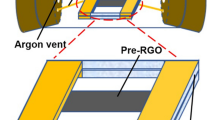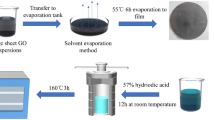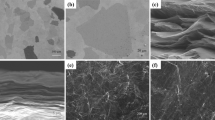Abstract
Graphene films have attracted much attention as a heat dissipation material due to their unique thermal transfer behavior that exceeds that the performance of graphite. However, the very high thermal annealing temperature (~ 3000 °C) required to reduce the graphene oxide (GO) films leads to high manufacturing costs and restricts its broader application in thermal management applications. In this study, a modified-graphene (m-Gr) film was fabricated by vacuum-filtering GO suspensions with added glucose, followed by thermal annealing at 1000 °C. Oxygen-containing functional groups were effectively eliminated during annealing and activated carbon atoms from the decomposition of glucose molecules repaired defects in the graphene sheets to restore large areas of the π-conjugated structure. The as-obtained m-Gr films showed excellent in-plane thermal conductivity ~ 1300 Wm−1 K−1 and much more efficient heat removal than pristine-reduced graphene oxide films. This high thermal conductivity of m-Gr films provides opportunities for their use in next-generation commercial electronics.








Similar content being viewed by others
References
Balandin AA (2011) Thermal properties of graphene and nanostructured carbon materials. Nat Mater 10(8):569–581
Sukhadolau AV, Ivakin EV, Ralchenko VG, Khomich AV, Vlasov AV, Popovich AF (2005) Thermal conductivity of CVD diamond at elevated temperatures. Diam Relat Mater 14:589–593
Malekpour H, Chang KH, Chen JC, Lu CY, Nika DL, Novoselov KS et al (2014) Thermal conductivity of graphene laminate. Nano Lett 14(9):5155–5161
Novoselov KS, Geim AK, Morozov SV, Jiang D, Zhang Y, Dubonos SV et al (2004) Electric field effect in atomically thin carbon films. Science 306:666–669
Balandin AA, Ghosh S, Bao W, Calizo I, Teweldebrhan D, Miao F et al (2008) Superior thermal conductivity of single-layer graphene. Nano Lett 8(3):902–907
Nika DL, Balandin AA (2017) Phonons and thermal transport in graphene and graphene-based materials. Rep Prog Phys 80(3):036502
Dikin DA, Stankovich S, Zimney EJ, Piner RD, Dommett GHB, Evmenenko G et al (2007) Preparation and characterization of graphene oxide paper. Nature 448:457–460
Gao X, Jang J, Nagase S (2010) Hydrazine and thermal reduction of graphene oxide: reaction mechanisms, product structures, and reaction design. J Phys Chem C 114(2):832–842
Kargar F, Barani Z, Balinskiy M, Magana AS, Lewis JS, Balandin AA (2019) Dual-functional graphene composites for electromagnetic shielding and thermal management. Adv. Electron. Mater. 5(1):1800558
Shen B, Zhai W, Zheng W (2014) Ultrathin flexible graphene film: an excellent thermal conducting material with efficient EMI shielding. Adv Funct Mater 24(28):4542–4548
Xin G, Sun H, Hu T, Fard HR, Sun X, Koratkar N et al (2014) Large-area freestanding graphene paper for superior thermal management. Adv Mater 26(26):4521–4526
Peng L, Xu Z, Liu Z, Guo Y, Li P, Gao C (2017) Ultrahigh thermal conductive yet superflexible graphene films. Adv Mater 29(27):1700589
Renteria JD, Ramirez S, Malekpour H, Alonso B, Centeno A, Zurutuza A et al (2015) Strongly anisotropic thermal conductivity of free-standing reduced graphene oxide films annealed at high temperature. Adv Funct Mater 25(29):4664–4672
Wu H, Drzal LT (2012) Graphene nanoplatelet paper as a light-weight composite with excellent electrical and thermal conductivity and good gas barrier properties. Carbon 50(3):1135–1145
Hou Z-L, Song W-L, Wang P, Meziani MJ, Kong CY, Anderson A et al (2014) Flexible graphene–graphene composites of superior thermal and electrical transport properties. ACS Appl Mater Interfaces 6(17):15026–15032
Song N-J, Chen C-M, Lu C, Liu Z, Kong Q-Q, Cai R (2014) Thermally reduced graphene oxide films as flexible lateral heat spreaders. J Mater Chem A 2(39):16563–16568
Kang D, Shin HS (2012) Control of size and physical properties of graphene oxide by changing the oxidation temperature. Carbon Lett 13(1):39–43
Chen J, Li YR, Huang L, Li C, Shi GQ (2015) High-yield preparation of graphene oxide from small graphite flakes via an improved Hummers method with a simple purification process. Carbon 81(1):826–834
Li X-H, Kurasch S, Kaiser U, Antonietti M (2012) Synthesis of monolayer-patched graphene from glucose. Angew Chem 51(38):9689–9692
Cheng M, Yang R, Zhang L-C, Shi Z-W, Yang W, Wang D-M et al (2012) Restoration of graphene from graphene oxide by defect repair. Carbon 50(7):2581–2587
Li H-L, Dai S-C, Miao J, Wu X, Chandrasekharan N, Qiu H-X et al (2018) Enhanced thermal conductivity of graphen/epolyimide hybrid film via a novel “molecular welding” strategy. Carbon 126:319–327
Chang Y-Z, Han G-Y, Xiao Y-M, Zhou H-H, Dong J-H (2017) A comparative study of graphene oxide reduction in vapor and liquid phases. New Carbon Mater 32(1):21–26
Vallés C, Núñez JD, Benito AM, Maser WK (2012) Flexible conductive graphene paper obtained by direct and gentle annealing of graphene oxide paper. Carbon 50(3):835–844
Mattevi C, Eda G, Agnoli S, Miller S, Mkhoyan KA, Celik O et al (2009) Evolution of electrical, chemical, and structural properties of transparent and conducting chemically derived graphene thin films. Adv Funct Mater 19(16):2577–2583
Wang J, Ran R, Sunarso J, Yin C, Zou H, Feng Y et al (2017) Nanocellulose-assisted low-temperature synthesis and supercapacitor performance of reduced graphene oxide aerogels. J Power Sour 347:259–269
Zhu C, Guo S, Fang Y, Dong S (2010) Reducing sugar: new functional molecules for the green synthesis of graphene nanosheets. ACS Nano 4(4):2429–2437
Fang Y, Luo B, Jia Y, Li X, Wang B, Song Q et al (2012) Renewing functionalized graphene as electrodes for high-performance supercapacitors. Adv Mater 24(47):6348–6355
Figueiredo JL, Pereira MFR, Freitas MMA, Órfão JJM (1999) Modification of the surface chemistry of activated carbons. Carbon 37(9):1379–1389
Chen C-M, Huang J-Q, Zhang Q, Gong W-Z, Yang Q-H, Wang M-Z et al (2012) Annealing a graphene oxide film to produce a free standing high conductive graphene film. Carbon 50(2):659–667
Ferrari AC, Meyer JC, Scardaci V, Casiraghi C, Lazzeri M, Mauri F et al (2006) Raman spectrum of graphene and graphene layers. Phys Rev Lett 97(18):187401
Bagri A, Mattevi C, Acik M, Chabal YJ, Chhowalla M, Shenoy VB (2010) Structural evolution during the reduction of chemically derived graphene oxide. Nat Chem 2(7):581–587
Eigler S, Dotzer C, Hirsch A (2012) Visualization of defect densities in reduced graphene oxide. Carbon 50(10):3666–3673
Cançado LG, Takai K, Enoki T, Endo M, Kim YA, Mizusaki H (2006) General equation for the determination of the crystallite size La of nanographite by Raman spectroscopy. Appl Phys Lett 88(16):163106
Sheng Z-H, Shao L, Chen J-J, Bao W-J, Wang F-B, Xia X-H (2011) Catalyst-free synthesis of nitrogen-doped graphene via thermal annealing graphite oxide with melamine and its excellent electrocatalysis. ACS Nano 5(6):4350–4358
Zhang J, Shi G, Jiang C, Ju S, Jiang D (2015) 3D bridged carbon nanoring/graphene hybrid paper as a high-performance;ateral heat spreader. Small 11(46):6197–6204
Zhuo H, Hu Y-J, Tong X, Chen Z-H, Zhong L-X, Lai H-H et al (2018) A supercompressible, elastic, and bendable carbon aerogel with ultrasensitive detection limits for compression strain, pressure, and bending angle. Adv Mater 30(18):1706705
Ding J, ur Rahman O, Zhao H, Peng W, Dou H, Chen H et al (2017) Hydroxylated graphene-based flexible carbon film with ultrahigh electrical and thermal conductivity. Nanotech. 28:(39)LT01-9
Wang N, Samani M-K, Li H, Dong L, Zhang Z-W, Su P et al (2018) Tailoring the thermal and mechanical properties of graphene film by structural engineering. Small 14(29):1801346
Acknowledgements
The authors acknowledge financial support by the “13th Five-Year Plan” Civil Aerospace Technology Pre-Research Project of the State Administration of Science, Technology, and Industry for National Defense (501-01-2018-0167, A2180150); the Fundamental Research Funds for the Central Universities (D2175010); and the Joint Fund for Equipment Pre-Research of Ministry of Education of China (6141A02022520).
Author information
Authors and Affiliations
Corresponding authors
Ethics declarations
Conflict of interest
The authors declare that they have no conflict of interest.
Additional information
Publisher's Note
Springer Nature remains neutral with regard to jurisdictional claims in published maps and institutional affiliations.
Electronic supplementary material
Below is the link to the electronic supplementary material.
Rights and permissions
About this article
Cite this article
Li, J., Chen, XY., Lei, RB. et al. Highly thermally conductive graphene film produced using glucose under low-temperature thermal annealing. J Mater Sci 54, 7553–7562 (2019). https://doi.org/10.1007/s10853-019-03406-x
Received:
Accepted:
Published:
Issue Date:
DOI: https://doi.org/10.1007/s10853-019-03406-x




